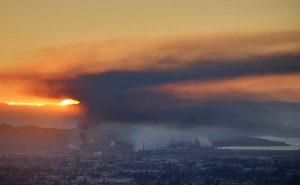
Contra Costa Health Services has posted a succinct "Frequently Asked Questions Related to the Chevron Fire on August 6, 2012." [PDF] It's good information -- cleaning fruits, vegetables, avoiding groundwater, health impact, etc.
I republish it here, in its entirety:
1. What are the health impacts from the refinery fire?
Smoke can cause throat and eye irritation, though it generally is not serious
if the exposure is limited. These symptoms should resolve on their own after a few days for most people. Exposure to smoke can be more serious for people with pre-existing lung disease, such as asthma, and they may experience wheezing or have trouble breathing. As of August 8, more than 1,700 people have gone to the emergency room with nose, throat or eye irritation or respiratory issues, although none have been hospitalized.2. What chemicals were released into the air and how dangerous are they?
A variety of chemicals were released during the Chevron Richmond refinery fire. (See list of chemicals from each sample location.) Smoke particulates, which are what makes smoke black, were the major concern during this fire. Smoke particulates can irritate the throat, lungs and eyes particularly in those with pre-existing lung disease, such as asthma. Benzene, a chemical that can cause cancer, and other toxic chemicals can also be present in smoke. Test results from air samples that were taken by Contra Costa Hazardous Materials Response Team and staff from the Bay Area Air Quality Management District (BAAQMD) were analyzed by BAAQMD and show the level of benzene and other toxic chemicals was below harmful levels during the fire and poses no risk of cancer. We do not have good measurements of the smoke particulates that impacted the community.
3. Is it safe to eat fruits and vegetables from my garden?
Yes, it’s safe. It’s always a good idea to wash fruits and vegetables before eating. If you live in an area that was affected by the refinery fire, you can wash fruits and vegetables from your garden with soap and a mild detergent (like liquid dish soap). Washing your fruits and vegetables will remove any particulates that might have been on the surface from smoke. You also can peel off the outer layer of lettuce or peel your fruit if you are concerned.
4. Is our water safe for drinking?
The tap water in Richmond is one of the best waters in the country and it is safe for you to drink and to give to your pets. The ground water from local wells in Richmond should not be used for drinking by you or your pets.
5. What should I do if there is soot on my car, patio furniture or outdoor play structures?
If there is residue on your car, patio furniture or outdoor play structure wash it with a mild detergent and water.
6. Why was shelter-in-place lifted if the air sample results aren't in yet?
The shelter-in-place was lifted because the fire at Chevron was under control and our hazardous materials monitors confirmed there was no ongoing exposure.
7. What should I do if I am having trouble breathing or have burning eyes and a sore throat?
People who are experiencing trouble breathing should seek medical attention. If you have burning eyes and a sore throat contact your health care provider.
8. Is there any assistance in paying for my medical expenses related to this incident?
Contact Chevron for information regarding payment of medical expenses or claims. You can reach them at 510-242-2000 for general information or at 1-866-260-7881 for claim information.